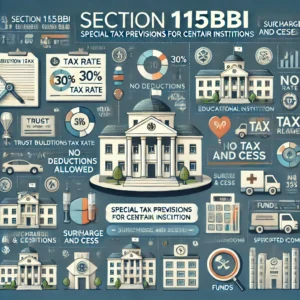The concept of the Assessing Officer (AO) plays a critical role in the administration of income tax in India. Defined under Section 2(7A) of the Income Tax Act, 1961, this provision outlines the powers and jurisdiction of various authorities tasked with assessing the income of taxpayers. Introduced by the Direct Tax Laws (Amendment) Act, 1987, the definition of Assessing Officer has undergone significant amendments over the years to clarify and expand its scope.
In this SEO-optimized guide, we will explore the evolution, legislative framework, judicial interpretations, and key features of Section 2(7A), helping you understand the importance of this provision in India’s tax system.

1. Introduction to the Assessing Officer
An Assessing Officer is an income-tax authority empowered to assess and process tax liabilities. The term was formally introduced by the Direct Tax Laws (Amendment) Act, 1987, effective April 1, 1988, to streamline tax administration and ensure accountability.
The Assessing Officer is responsible for:
- Verifying income tax returns.
- Assessing taxable income and tax liability.
- Issuing refunds or demand notices based on assessments.
2. Legislative Evolution of Section 2(7A)
Key Amendments and Their Implications
- Finance (No. 2) Act, 1996
- Included Deputy Commissioners within the scope of Assessing Officers.
- Effective October 1, 1996.
- Finance (No. 2) Act, 1998
- Expanded the definition to include Assistant Directors and Deputy Directors.
- Effective October 1, 1998.
- Finance Act, 2007
- Clarified the inclusion of Additional Commissioners and Additional Directors with retrospective effect:
- June 1, 1994 for Additional Commissioners.
- October 1, 1996 for Additional Directors.
- Clarified the inclusion of Additional Commissioners and Additional Directors with retrospective effect:
3. Definition of Assessing Officer: Section 2(7A)
As per Section 2(7A), an Assessing Officer includes the following authorities, provided they are vested with jurisdiction under Section 120 or other provisions of the Income Tax Act:
- Assistant Commissioner (Section 2(9A)).
- Deputy Commissioner (Section 2(19A)).
- Assistant Director (Section 2(9B)).
- Deputy Director (Section 2(19D)).
- Income-tax Officer (Section 2(25)).
- Additional Commissioner (Section 2(1C)).
- Additional Director (Section 2(1D)).
- Joint Commissioner (Section 2(28C)).
- Joint Director (Section 2(28D)).
4. Powers and Jurisdiction of the Assessing Officer
The jurisdiction and powers of Assessing Officers are defined by:
- Section 120: Assignment of jurisdiction based on territorial, subject-matter, or taxpayer category.
- Section 124: Territorial jurisdiction and power to assess income.
- Section 116: Enumeration of income-tax authorities, including AOs.
Assessing Officers can:
- Conduct inquiries.
- Issue notices for scrutiny or reassessment.
- Make adjustments to income tax returns.
- Handle disputes or objections raised by taxpayers.
5. Judicial Interpretations
Several courts have provided clarity on the scope and role of Assessing Officers under Section 2(7A):
- Peerless General Finance & Investment Co. Ltd v. Assessing Officer (2001):
- Extended the definition of AO to include those performing specific functions, not limited to regular assessments.
- Reckitt Colman of India Ltd. v. Asst. CIT (2001):
- Highlighted that Assessing Officers could be designated by Commissioners for specific jurisdictions or cases.
6. Retrospective Amendments
To resolve ambiguities, the Finance Act, 2007, introduced retrospective amendments to the definition of Assessing Officer:
- Inclusion of Additional Commissioner:
- Effective June 1, 1994.
- Inclusion of Additional Director:
- Effective October 1, 1996.
- Inclusion of Assistant Director:
- Effective April 1, 1988.
These amendments ensure consistency and clarity in the application of the law.
7. Departmental Clarifications
Circular No. 545 (1989)
- Discussed jurisdictional powers under Section 120.
Circular No. 772 (1998)
- Addressed redesignation of authorities.
Circular No. 3/2008
- Clarified the retrospective amendments made by the Finance Act, 2007.
9. Important Case Laws
- CIT v. Neeru Gambhir (2008): Defined the expansive scope of Section 2(7A).
- CIT v. Bindal Apparels (2008): Reiterated the jurisdictional powers of AOs under Section 120.
FAQs About Assessing Officers
Q1. Who is considered an Assessing Officer under the Income Tax Act?
An Assessing Officer is any income-tax authority designated under Section 2(7A), including Assistant/Deputy Commissioners, Income-tax Officers, and others, vested with jurisdiction under Section 120 or other provisions.
Q2. What are the powers of an Assessing Officer?
Assessing Officers can conduct inquiries, issue notices, assess tax liability, and handle reassessments and disputes.
Q3. Can multiple authorities act as Assessing Officers for the same taxpayer?
Yes, depending on the jurisdiction assigned under Section 120 or by the Central Board of Direct Taxes (CBDT).
Q4. Are retrospective amendments common for the definition of Assessing Officer?
Yes, amendments such as those made by the Finance Act, 2007, clarify the scope of authorities covered under Section 2(7A).
Conclusion
The role of the Assessing Officer, as defined under Section 2(7A), is integral to India’s tax administration. With evolving legislation and judicial clarifications, taxpayers and professionals must stay updated on the responsibilities and jurisdiction of AOs to ensure compliance and address disputes effectively.
For more in-depth content on tax laws and amendments, visit SmartTaxSaver.



